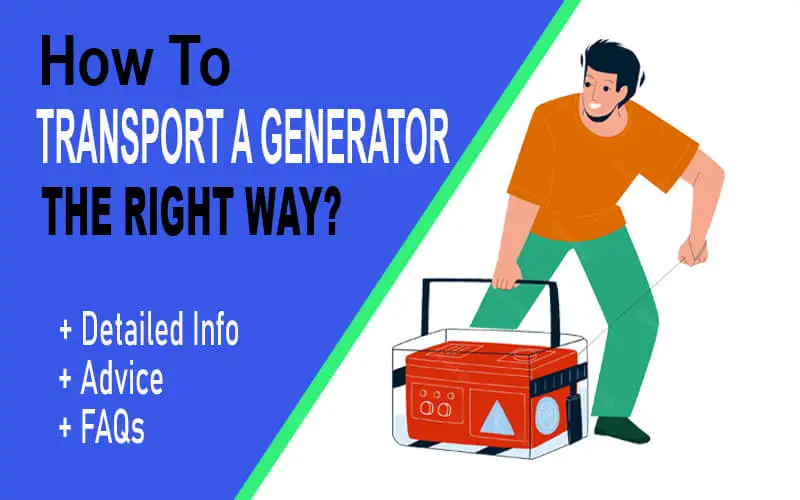How to Transport a Generator the Right Way? [+Safely] 2023
Do you know how to transport a generator the right way and safely? If no! then this article is for you 🙂 Generators are devices that turn electricity into motion. They come in a variety of shapes and sizes, but all have one common goal: to create power. These devices were the only power sources in the early days of electricity.
Today, generator options range from small home generators to large commercial units. The generator is popular for businesses and homeowners because it can be operated quickly and efficiently.
Generators are popular in areas with a high demand for electricity, such as countries with high temperatures or those with extensive oil wealth.
With this increased use of generators, there is a greater need for generator transport awareness in users. Transporting generators is a slightly technical task, so users must be well read on how to properly unplug, load, and manage the generator for the process to ensure safety.
How to Transport a Generator the Right Way?
A generator is a powerful and necessary tool for many businesses. If you are transporting a generator the right way, it can help protect your business from theft and reduce carbon emissions.
Here are some tips to help you transport a generator the right way:
Place the generator in an inconspicuous place. Ensure it is carefully concealed and far away from potential hoodlums.
Use bungee lines or secure lashes to tie down the generator to a vehicle or dock. This will assist with keeping it no problem at all while on the way.
Use caution when transporting generators that are heavy or large. Make sure to use common sense when securing them so that they do not damage other equipment or vehicles.
Can a generator be transported on its side?
Transporting a generator on its side or upside down is not recommended and can be dangerous. Here’sHere’s why:
First, when a generator is turned on its side or upside down, the oil can start to leak out. This can make the motor overheat and hold onto up, prompting costly fixes.
Second, the generator’s fuel tank is not designed to be used in this way. If the fuel leaks out, it could cause a fire.
Third, turning the generator upside down on its side can damage the electrical components. This could lead to a short circuit and potentially start a fire.
For these reasons, it’s best to transport your generator upright and keep it level at all times.
Is it safe to travel with a generator?
As the weather gets colder and power outages become more common, people may be tempted to bring a generator with them on their next trip. However, generators are not allowed in carry-on or checked bags by any airline. Also check the voltage of your genset.
There are a few reasons for this.
First, generators can be extremely loud, which would not make for a pleasant flying experience for anyone seated near the person with the generator.
Second, generators produce fumes that could be harmful to other passengers in the cabin.
If you absolutely must travel with a generator, you can do one thing or more to increase your chances of being able to bring it on the plane with you.
Call the carrier quite a bit early and get some information about their strategies in regards to generators. Some airlines may make exceptions for medical devices that require power. Solar generators are safe to travel with.
FAQs: How to Transport a Generator?
How to transport an RV portable generator?
Here are a few tips on how to transport your RV portable generator safely:
The best way to transport an RV portable generator is on a trailer. This will keep the generator from bouncing around while driving and protect it from the elements.
If you don’t have a trailer, you can still transport your portable generator safely by putting it in the bed of a pickup truck. You can basically snatch it while you’re driving, so it doesn’t move around.
It is undoubtedly possible to move your RV portable generator with a little bit of arranging. Just be sure to take precautions to ensure that it arrives safely at its destination.
How to transport a Worksite Generator?
Most Worksite Generators are too large and heavy to transport without loading them onto a trailer or securing them to the bed of a truck.
If you need to move your generator, follow these steps to do so safely:
First, attach the generator to the trailer or truck bed using chains or straps. Ensure the generator is secured so it doesn’t shift during transport.
Next, begin the generator and let it run for a couple of moments to accurately guarantee it’s working. Once you’ve confirmed that the generator is running smoothly, you can begin loading any tools or equipment you need onto the trailer or truck bed.
Finally, when you’re ready to hit the road, be sure to drive slowly and carefully so as not to damage the generator or any of your equipment. With these tips in mind, transporting your Worksite Generator should be a breeze.
Is it possible to transport a generator in a car?
No, generators should not be placed inside vehicles.It is basically not worth the gamble to do this, as there are numerous risks implied.
As far as one might be concerned, generators produce carbon monoxide gas, which can rapidly move toward perilous levels inside a vehicle. Even if the windows are rolled down, there is nowhere for the gas to go, and it can quickly overwhelm and kill anyone inside.
Another danger is fire. Generators produce a lot of heat, and if they are placed inside a car, there is nowhere for that heat to go. This can easily lead to a fire, spreading quickly and destroying the entire vehicle.
It is generally a poorly conceived notion to put your generator inside a vehicle. It’s simply not worth the risk.
Can I put a generator in my trunk?
In the event that you’re similar to a great many people, you’ve most likely puzzled over whether you can place a generator in your trunk at some point. Yes, that’s true.
Before doing so, however, you need to keep a few things in mind.
For one, generators can be heavy, so make sure your trunk can handle the weight.
Secondly, since generators produce exhaust, you’ll want to make sure the exhaust fumes don’t build up in your trunk and cause problems.
Here are a few tips to help you safely and effectively use a generator in your trunk:
- Choose a generator that’s the right size for your needs.
- A firm, level surface is ideal for placing the generator. This will assist with keeping it from spilling.
- Ensure the generator is sufficiently ventilated.
Conclusion:
It is essential to remember a few key points when transporting a generator. Be sure to use the proper vehicle to avoid damaging the generator, and take extra care when loading and unloading it. With a touch of arranging and planning, you can securely move your generator to any place it requires to go.


![Find Out Now! Best Whole House Generators In 2023 [#3 Is Life-Saving]](https://prohouseideas.com/wp-content/uploads/2022/12/best-whole-house-generators-768x480.webp)


![How to Measure Humidity? [+Right Way +Advice + FAQs] 2023](https://prohouseideas.com/wp-content/uploads/2022/10/how-to-measure-humidity-768x480.webp)
![How to Clean a Vicks Humidifier? [Daily & Weekly Plan] 2023](https://prohouseideas.com/wp-content/uploads/2023/01/how-to-clean-a-vicks-humidifier-768x480.webp)
